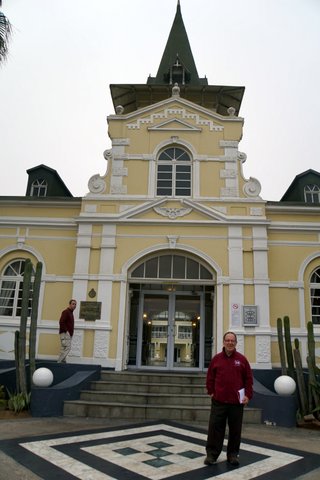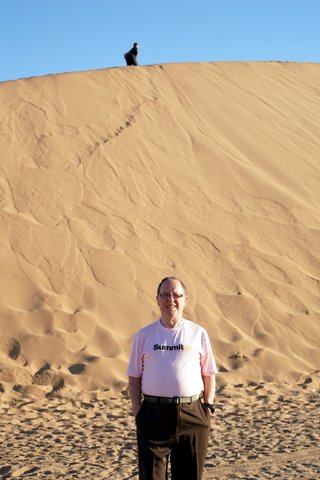
The Swakopmund Hotel was built by Germans as a railroad station circa 1900. Namibia was a German colony, German SW Africa at the time. Town architecture still has some German art deco buildings.
We’re in Swakopmund, Nambia, 883 miles from Johannesburg and 4 degrees closer to the equator (22 degrees) according to my gps. It’s on the west coast of south Africa, where the Namib desert fronts the cool Atlantic Ocean.
Don’t be deterred by the name, which comes from the Swakop river, which means, in the local language (politely put) rear end. It’s a city that a century ago was part of German Southwest Africa until the British and South African armies captured it, and the colony became part of South Africa, initially as war booty and as a mandate under the League of Nations. Parts of the city architecturally date back to the German days, including the hotel we’re staying at, which back in the day was a railroad station that has been converted to a five star hotel. It could be somewhere in Bavaria. A lot of the tourists here are German (the boat trip I took this morning had German/English explanations, with a French woman translating for her countrymen), and I understand there’s direct flights from Frankfurt to Namibia. The restaurant some of us at tonight is the Hansa House, and it did serve schnitzel, but it also served game, and I could not resist the springbok steak!
The fact that it was a German colony should tell you something if you know anything about the colonial period: the Germans came late and essentially got what no one really wanted. Portugal, the first to seize colonies, took Angola to the North, and the Dutch/British South Africa to the South. Of Namibia, apparently the most desirable part was Walvis Bay, a good harbor, which the British claimed until eventually ceding it to the Germans.
The Namib desert is quite extensive, as we saw flying over it; I can compare it only to Mongolia in my experience, or the Taklamakan, but you might think of it as parts ohef Nevada/Wyoming. That it is on the ocean provides some livelihood. Tourism is one attraction. As I drove up to the boat, I was thinking “Florida” because of the new houses fronting the ocean; the image sharpened when we stopped at a mudflat to photograph the flamingos! Another was salt. As you may know, salt was part payment to the Roman legions; hence, “salary” derived from it. Namibia is a major exporter of salt. I can see the salt company out my window. A third is a port expansion going on here, apparently not entirely successful, which Chinese help; the thought was to bring to the ocean exports from landlocked countries nearby (Zambia, Zimbabwe, etc.). That was kind of the German thought, too, in building the railroad station where I’m staying; they found it not viable, too.
The Atlantic here does provide some respite. It’s too cold for swimming, but as I discovered on a dolphin watch this morning, has spawned an oyster industry. Because of the current along the coast, oysters grow to full size in 9 months; elsewhere, it takes two years. One local entrepreneur found a way to breed babies ashore (I think he said 400 tons a month), then the oysters get put in cages in the ocean to grow. The captain assured us they were the best oysters in the world, and at an onboard lunch almost persuaded me! The tour also featured a pelican that came on cue on the boat, a sea lion that did the same, and a voyage out to an island where there was a colony. There are reputedly more seals in Namibia (2.5 million) than people (2 million). That was my morning activity, since we were free to do what we wanted, and I thought, “sea and sand; do both”.
The second part was an FDIB sponsored trip to Dune 7, a huge sand dune that makes Mount Tom at the Indiana Dunes look like a junior high player. The dunes were featured in Lawrence of Arabia, and one of our faculty used his free time to fly in a small plane to an area where the dunes are otherwise inaccessible. Our guide told us of one tribe that lives in the interior gets so little rain that they wash with dirt….I wonder how many Scouts will start using that as an excuse, but I warn them in advance that they’re not in Namibia.
Namibia’s history reflects in part the turbulence of the 20th century. The first German governor of SW Africa was Herman Goering’s (of Nazi infamy) father. A local uprising of the dominant Herero tribe led to what has been called the first genocide of the 20th century—a massacre of something like a half million Herero and the poisoning of the wells, etc. Later in the century, Namibia, part of South Africa, became embroiled in the Cold War. I think most of us of the right age think of the Cold War as probably Asia, Russia and Eastern Europe, and Cuba. Namibia independence fighters attracted support from Angola, which in turn invited Cuba freedom fighters, which in turn encouraged the United States to provide support for South African troops. The consequences of that civil/cold war today are that Namibia tends to side with China and even North Korea. Monuments in Windhoek (the capital—we’re leaving for there tomorrow morning) I’ve been told, look more like Kim Il Sung than local leaders of the revolution (who are still in power here).
Another major product (even though over half of the population lives in poverty, the average income is $11,000, which means a few people have a lot of money!) is uranium, and we’re visiting a uranium mining company tomorrow. I’ve been told it’s Chinese owned, but I’ll give you a report on that tomorrow—hopefully, not a “glowing” one.




One Response to Namibia: Salt of the Earth?